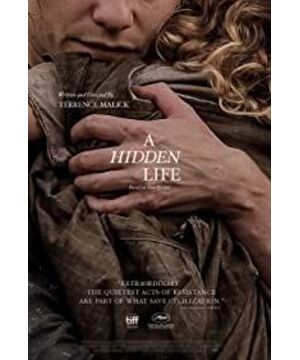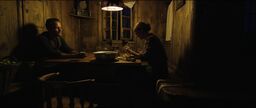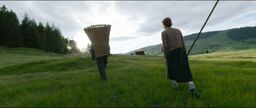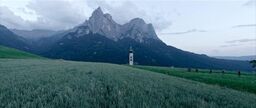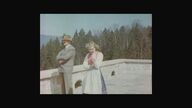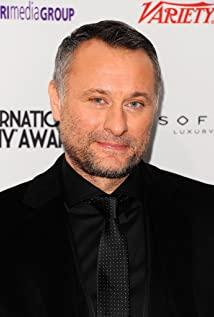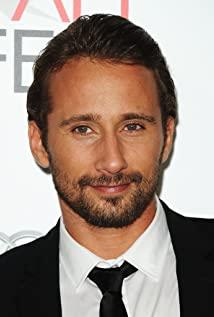This is a very special work and Malick’s most ideal work. Its core motif is the original goodness of human nature (from a certain point of view, it returns to what was discussed in his earliest work Badlands In the second half of A Hiden Life, we saw the Nazi officer escorting the actor playing alone on the street, dancing and enjoying himself, just like one of the young police officers in Badlands who finally caught the actor Kit was playing with guns and guns. Play cool, like a child.). This leads to the way the camera sees anyone and everything in the film—even the wicked. Malick believes that even the wicked, their souls are pure, but because of ignorance and temporary evil they fail to promote good.
The protagonist is very special. It can be said that there is no confrontation in this film (at most it is rejection.). The protagonist is more like a glimpse of the world of a person who has come to the world for a short time. This film and Malick's documentary Voyage of Time: Life's Journey can be said to be sister works, and the two should be understood together. In addition to discussing timeliness, I want to point out that there are several times in Voyage of Time that we will see a whole group of small fish swimming around a huge shark. This symbolizes, or points to life, All beings have lost their aura, spirituality, and the instinct of consciousness and enlightenment, and everything becomes dominated and controlled only by the unreleasable (cruel, violent, and evil). Looking back at A Hiden Life, the most painful and frustrating time for the protagonist is not to receive violence and humiliation, but to face the whole system and system (we see trial, The sentence is pronounced and the final reading on the eve of the death penalty.), the sad sacred music of Pärt and Górecki (the second part of the heart of the child and the final movement of the symphony of tragedy.) will sound at this time. A Hiden Life is not a suffering drama (this film does not intend to present the scene of Ling Chi, pain is not about the endurance and resistance of physical injury.). We will see the male protagonist staying confident, optimistic and thinking in prison. In prison, he reunited with a mad and foolish friend he had met when he was enlisted in the army, and became a bedtime inmate. They caught any gaps (avoid the jailer!), joking and chatting together, having fun in hardship, just like military training. In the old days, I even picked up a broken brick and played football in the dormitory cell.
Another theme of this film is truth (moral perfectionism) itself, as well as growing good and care. I have read some reviews abroad that put this film together with Scorsese’s Silence or compare them, but I think the two are much different-not the opposite, but the two concerns are fundamentally different. Scorsese is concerned with the dialectics of beliefs, while Malick is concerned with more primitive and basic feelings (that is, the moral perfectionism that Emerson thinks about-starting from the simplest conscience and feelings facing what you see, what you hear, and what you feel. Thinking and making choices, and this is the theme of the title ─ ─ unobtainable, insignificant and insignificant conscience, light of life.), faith here is the second, it is based on feelings, perception, and then follow Thinking and unfolding (or you have to look at it with time to gain meaning.). We see the protagonist talking with the judge in charge in the judge’s office. The judge is curious about the protagonist, and a little awed by the protagonist’s beliefs. He asks the protagonist if he is going to be tried (reversed inwardly), and the protagonist replied that he cannot be tried. Anyone who says he is an ignorant person just thinks from the bottom that he cannot do a wrong thing against his conscience, nothing more. In the movie, the protagonist is more like a child (faced with a stout jailer, he appears thin and thin.), a stubborn, stubborn, stubborn, and unwilling to harm the innocence and sincerity (you will find that he partially affected the surrounding People, save a kind of good and people back [here to borrow the words of a commenter Casey Spinks, the article is linked at the end of the article.].), not the martyrs and martyrs who insist on glory.
A Hiden Life is not as simple as it seems on the surface (on the whole, it pursues a pure and clear state.), it still contains many low-key and subtle messages, and Malick has his own unique thinking and practice on images.
Many comments point out that this movie is long and repetitive, and I personally think it's okay. I think one of the reasons for the length of this movie is language. The film involves correspondence and dialogue, and the characters have a lot of monologues (most of the comments will focus on the inspiring photography in the Malick film, but in fact the expression of language is more fundamental and pre-existing, and the language is directed to the vast world and another person Express and talk, the language expresses and penetrates into the infinite storage of existence, expressing a person's experience, thoughts and thoughts in the world; we see the title of Malick's last feature film: Song To Song──The title is extremely simple and wonderful and difficult to translate. It can be understood as the lingering conversion of one song after another [Life of], and it can also be understood as singing to another person or trying to chant with it, Or trying to sing the essential secrets and dream songs of the world, we saw the first monologue of the hero in the film, saying that we [we] must sing, for the sake of people-singing is to find and express, so that the inner meaning of the world can Express to us. ), there are scenes and processes of life, labor, and games. In Malick’s point of view, the focus is on the length of a person’s "existence", which is the living space, the space for activities, and the time to allow breathing and thinking about things (breathing is very important, breathing represents our space and time The openness of this means our freedom.) It lies in the time and actions that a person spends in the world. This makes Malick and Ozu Yasujiro (Ozu's lens breaks the 180-degree line of frontal actors, just to allow the character's existence to occupy an absolutely solemn position on the screen.), or Rivette (the opening of the game's body and the effect of the body on the existence "Touch.") and Jean-Marie Straub and Danièle Huillet (the flow and expansion of language in the space of the world.) are connected together. In Malick’s movies, there is a dynamic of constantly returning to the origin of "I am here," and then constantly re-starting and unfolding in time (this is a sign of the body), rather than a single long line that does not look back. Narrative line. And the way an actor performs is like a person playing and talking, constantly touching and touching with his body or hands, and constantly touching various things and animals in the world (one of the pleasures of watching a Malick movie is that you can Count how many times and how many kinds of animals have appeared in the movie ──Animals are animals that live together with humans, neighbors of humans, and others of humans.) There is a constant presence in the world and The approach of sentient beings and ruthless things in the world (this is what Malick’s camera does-the camera is always moving, approaching, and curious. The use of jump cuts is precisely to "touch" a kind of time. The existence of fleeting sensations.). Here, the expression of the body and the proximity of the camera to everything form a game-like poetry, a poetic expression of expression-we see A Hiden Life's execution scene is represented as a stage on which a magician performs, which is a kind of expression conversion. "Expression" never follows reality, but runs through imagination and reality. Malick directed the actors' performance (in Badlands, he told Martin Sheen that the use of a pistol was seen as a magic wand.) It was not like Hou Xiaoxian. Hou Xiaoxian's method is to form an external observation, just like a child who sees the scenes of the sophistication of the adults and comprehends it without understanding. Through this kind of onlooker perspective, Hou Xiaoxian lays out layers of concealment in front of him. There are so many inner meanings that you can’t see through at a glance, just like he loves the shadows in the scene very much. (Alfonso Cuarón’s Roma’s deep focus lens is not like The reason for Hou Xiaoxian lies in this. Roma's fixed lens looks very clean and thorough. On the one hand, it is related to his desire to show and let your eyes find things in the space. On the other hand, it is the expansion of a space that women understand. Related──Women have their own perception of staying in a space or opening a space, in which there is a certain kind of careful attention [especially the heroine is a person who takes care of the space.]. Alfonso wants to spread, expand, and expand through this feminine perception. To reach a kind of harmony.). The performances in Malick’s films are based on the essential way of language expression and narration (so we will see The Thin Red Line’s performances are quite different from Saving Private Ryan.), Malick’s actor performances seem to be Hypocritical, in fact, it is not. This is a way of performance similar to expressionism. The emphasis is on the inner understanding and the truth of expression, rather than the truth of reality (this is also A Hiden Life controversially mixes German and English as a logical starting point-when there is communication, the language automatically becomes English and becomes the native language of the director/poet. It is very strange here. It mixes natural and anti-natural things, which makes the film a certain kind of alienation, implying a rational pragmatism tendency and making you suspicious to search for clues contained in the unreasonable places in the film. ), this is very similar to literary writing (we are looking back at the precedence of the language just spoken and the confession of language to the world. In Malick, it has always been human language or people with language facing the world [and the tree of speech, The unfolding of the relationship between Silent Animals.)! Bresson claims his images are Cinématographe, while Malick here fully embodies a logic and emotion written in literature, expressed in language (and expressed in the body) (telling of "existence", "presence" [as I say, therefore I am.]) Expanded image. This is very different from the general understanding of film production.
Many small details of A Hidden Life are both weird and mysterious. You must master and understand these key points in order to truly understand what this work is talking about. For example, to inspire the protagonist and take action to have a conversation with the church muralist. When the painter tells the protagonist that he is only painting an image of Christ that pleases and comforts the believers, rather than the real face of Christ (the camera is accompanied by words and looks around the mural Some people may think of Christ himself in the Bible saying that he will bring swords instead of peace, but Malick shows the sunshine of nature and let the gentle sunshine fall on the shoulders of the protagonist. There is no declaration of war as understood above. It is not so much the manifestation of the doctrine of Christianity, but rather the transcendental natural theology of Emerson's pursuit of truth, or Heidegger's pursuit of a more real commitment to survival and to truth.
This reminds me of the protagonist in Knight of Cups and Natalie Portman who went to meet a spiritual old man, and the old man narrated his insights (we noticed the language outside the picture in the image and the occasional flash of the image where the old man was present. The speech does not speak to each other-here shows a kind of freedom of editing, just point out that the person is talking on the way.), the video takes us to see some oriental gardens, which seems to be a kind of lazy or clichéd connection But this is not the case at all. Other parts of the movie have been suggesting that the modern urban space where our protagonist wanders is an ideal country built and built according to human vision, or an ideal temporary generation. So we will see casinos imitating buildings from all over the world in the film, we will see overly trimmed trees or tall and thin palm trees that grow artificially, and even witness a piece of work in an art gallery presenting a whole Lego In the toy city, countless toy cars are running on the elevated tracks of this city, and there is a constant stream. There is a woman (probably a pavilion official.) standing in the city, like a giant. Looking back, what we saw was a series of edits that were suddenly Chinese and then Japanese Oriental gardens (they were obviously fakes built in the United States.) The same thing, and here we have to express the truth with the old man’s language and from time to time in the movie. Look at the monologues of the various characters that appear (even characters that have never appeared before) together. The movie started with a quote from the recording of the deceased Shakespeare actor John Gielgud, not showing up but out of the picture (Knight of Cups is arguably one of the most radical [and fundamental] use of voice-overs in movies ever [Malick’s The Thin Red Line is another time. ]. ) Tells a dream and the scene seen in the dream, and in the image, we see clusters of sparks from the night city on the surface of the earth, and then the voice of the protagonist’s father intervenes (not to be finished by Gielgud.), start Tell his son that he had told a fairy tale when he was a child. A prince was on a mission to go to a foreign country, but he forgot his purpose and memory after drinking a banquet, so the king sent one envoy after another to find and rescue. In the movie, we constantly see helicopters hovering in the air to search, and the existence of various characters, like messengers, comes from the sky to the world. Like the protagonist, they are also forced to be in a state of forgetting (and remembering) to a certain extent, indulging in the world, and remembering something in the dark. This feeling is particularly strong every time they start a monologue, because when they start to speak, they have a state of examining everything beyond themselves, conveying their insights and insights in the human world and in this world at this height. , Like the declaration of truth. Looking back, the language of Gielgud's sermons is to anchor a height that lifts dust. Each character enters this height when they start to speak, restores memory, restores their noble nature, and speaks the truth. In this way, the film describes a boundary between the metaphysical and the subphysical, in order to define the essence of language, and this essence follows Emerson's understanding. Emerson's concept is very similar to Wang Yangming's "to conscience". Both believe that the heart can understand everything. For Emerson, everything that meets each other can therefore provide reference and become an explanation of the truth. From this place, Emerson further formed his concept of "self-learning" (like Wang Yangming's unity of knowledge and action.) and his poetics (and this is the poetics of Malick's images. Malick and his teacher Stanley Cavell was greatly inspired by Emerson’s thoughts. Both of them were based on Emerson’s thoughts to further explore the confrontation between skepticism and moral perfectionism. "Explore." ). Back to Malick, although the description of language can bring the understanding of truth to our eyes, it has always fallen into the language, like the protagonist wandering in an artificial endless city (it is both large and small, as if it can Put it in the palm of your hand—there is a sense of the Middle Ages.)—This is the meaning of those oriental gardens: the garden and the language of the (old man) are only a kind of proximity and temporary generation. In understanding, the truth is both clear and insignificant. Exhaustion, as the ability to understand and everything in the world, is both simple, universal and profound, just like the traces and images of the sun that can be seen everywhere in Malick's late films. And as Derrida said, the nature of the sun/light is black.
Let's go back to the weird details of A Hidden Life. There is another example in the film. For example, not long after the movie opened, after the heroine described the happy and fulfilling life of the couple, we saw the next scene where the heroine walked out of the farmhouse and looked up to the sky to search for the roaring Nazi military plane. In the previous paragraph, the graceful violin song with the heroine's narration and a series of images enters the end of the song. The intertwining of several violins conveys a sense of mystery (such as Secret Doctrine). It was heard that this overlap seemed extremely uncoordinated at first glance. It’s not like most commentaries point out just the sorrow and threat of Nazi oppression. The first paragraph of the movie ends when the protagonist comes to a forest (sacred bush!) and the following paragraph plays a game similar to hide-and-seek with his family. This game implies both the meaning and the use of the entire film. The aesthetics of sound (the film often comes with ringtones, reminiscent of Bresson’s Au Hasard Balthazar, and also reminiscent of certain features of the music of the sacred musician Arvo Pärt whose work Malick has repeatedly quoted: ringtones or music like ringtones The darkness sounds, disappears, or strengthens or crosses, such as the guidance of lightning or light.) In this game, the protagonist is blindfolded, and the wife (heroine.) and daughters knock on pots and let him search-it seems like here Point out the arrival of some kind of test and inquiry like looking for the Holy Grail. Before that, everything was just ignorant and lurking. However, the arrival of the soundtrack and engine sounds is not the only sign. Let's bring all this back to the beginning of the film quoting Leni Riefenstahl's "Triumph of the Will" fragment, and then think about the Upper Austrian valley before us-this is like a metaphor for the development and loss of control of the German spirit or the romantic spirit. You can further understand the madness of the German spirit as human madness and spiritual madness in the world (this reminds me of Herz aus Glas in Herzog and the prophet in Invincible's prophecies about humans/Nazis [insertion: Malick and Herzog is a very close friend.].), the whole thing hits like a whirlwind, but it is not just as evil as a plague, but like an event of nature (like Malick’s Days of Linda, the little girl in Heaven, described the devouring of hell's fire at the beginning of the film and the sudden engulfing and eruption of the locust plague in the second half of the film. ), or one of the infinite accumulations of existence and the events it reveals, it strikes and descends in one way and its appearance, unexplainably. There is a cosmic and temporality here ("coming" and "coming" mean temporality-from the perspective of temporality, it uses [symptomatic] "coming" to show what it is [therefore, there is The question of yes or no, and or not.]. Malick can be said to follow this understanding and choose to combine the swept by the Nazis with the music of the violin-leaving aside the understanding of human feelings, from the perspective of being, it It is a subtle [thing]. The operation, occurrence, and existence of things are very, very mysterious (in addition, the scene of Malick's handling of the death penalty also has a mysterious and weird existence-the death penalty here is very similar to the scene of magic, there is The magician in a tuxedo [executioner] and his assistant, a black curtain for cover, and a prop [guillotine] [plus a strange fantasy of the protagonist’s crazy friend: when the head is cut off, he bends down and puts his head down Pick it up and put it back, everything is intact as before, and the sun rises as usual.] And the benches and names waiting for the execution are like the usual, mediocre queuing and calling numbers to go to the public office for work or see a doctor [here is a little Kraft The meaning of card.].), this is something that is bigger than human and includes human participation. However, the film does not stop there. It also touches on the modern meaning of the Nazis—the Nazis feel and understand the arrival of the end of time (Germany Year Zero!), which forms a whole with the end of the film. The big dialectic. The end of the film also shows the time of nature, and the end of the time when the heroine faces her husband’s imagining and hopeful Christian eschatological salvation after her husband’s death, in a series of images (here is just imagination, just like the ending of The Tree of Life and Family reunion. The beach of The Tree of Life implies more the final boundary between imagination and the unknown, rather than the arrival of a heaven that eliminates death. We see that in the protagonist’s imagination, the mother is here to let go of her young brother who died young. , Bid farewell to it, disappear to nothing-this seaside is actually the boundary of existence.), we see that people understand what they have experienced in the previous time, get away from it and gain clarity, and restore their natural simplicity and kindness. A Hidden Life is an experience that touches time (1, the belief and original intention of beautiful things are tested in the tribulation and the prolongation of time. Second, the choice and decision produce a result, but there is another kind of unknown [here is not Talking about the eschatology of Christianity, which is always in the future, talks about salvation, but refers to the unfolding of time and occurrence, the unfolding of possibilities-truth is always a possibility. Toward the truth is not toward a foregone conclusion, but to enter the time when the possibility can be realized. In sex {"possibility can be realized" this point is borrowed from Cavell.} At the same time as this temporality is opened, its ownership is not entirely occupied by truth, on the contrary, there is no ownership here, but all possibilities Sex, or the opening of a fundamental possibility—maybe it may be possible.] Beyond this result, and unfolding simultaneously with the result—every moment of time becomes unknown. We can even understand the movie from this point. The film length and the protagonist say that he is an ignorant explorer - there is a wonderful and unspeakable ease in the protagonist's experience of everything. What I'm talking about here is not having fun in hardship, but about the feeling of time going down. ─We saw the protagonist stop at a cafe on his way back to prison after being escorted. When he stepped out of the cafe, he picked up an umbrella that fell on the ground and put it away. It did not seem to be an execution of faith, but There is a kind of ease and carelessness. We connect here with the fantasy of the protagonist’s crazy friend who took the head back. This expresses a feeling that time will continue forever, and there is no end to it. In addition, we see Malick. The entire section of the bridge where the protagonist beheaded is hidden, and then connected to the scene of the endless river. On the whole, everything implies a continuity towards an unknown future.), the existence and function of time-ignorance and enlightenment involve time . Here, Malik did not bet the entire movie on religion (in turn, the opening of religion/language to the interpretation and understanding of all possibilities.), there is also the temporality of nature (at the end of the movie) An image is an image of a cliff in a valley. It is like a wall, denying any thoughts attached to it.) Everything must be put back in nature to think (all Malick movies are contemplating nature, the world, Man and animal, indifference and emotion, humanity and moral display and comprehension.) Just as the sky cannot exist alone from the earth, so does eternity and change. Not towards a foregone conclusion, but to enter into the temporality where the possibility can be realized {"Possibility can be realized" borrowed from Cavell. } At the same time of this temporal opening, its ownership is not entirely occupied by truth. On the contrary, there is no ownership here, but all possibilities, or the opening of a fundamental possibility—maybe because of this. It can be possible. ] Beyond this result, it unfolds simultaneously with the unfolding of the result-every moment of time becomes unknown. We can even understand the length of the movie from this point and the fact that the protagonist said that he is an ignorant explorer-the protagonist has a wonderful and indescribable ease in the process of going through everything. This is not about having fun in pain. It’s the feeling of time going down—we saw the protagonist stop at a cafe on the way back to prison after being escorted. When stepping out of the cafe, he picked up an umbrella that fell on the ground and put it away. It doesn’t seem to be the execution of belief, but there is a kind of ease and carelessness. We connect this with the fantasy that the protagonist’s crazy friend said that he put his head back. This expresses a kind of time will continue forever, without end. I felt it all, and in addition, we saw the entire bridge where Malick beheaded the protagonist disappeared, and then connected to the scene of the endless river. On the whole, everything implies a stretch towards an unknown future. ), the film of the existence and function of time-ignorance and enlightenment both involve time. Here, Malik did not bet the entire movie on religion (in turn, the opening of religion/language to the interpretation and understanding of all possibilities.), there is also the temporality of nature (at the end of the movie) An image is an image of a cliff in a valley. It is like a wall, denying any thoughts attached to it.) Everything must be put back in nature to think (all Malick movies are contemplating nature, the world, Man and animal, indifference and emotion, humanity and moral display and comprehension.) Just as the sky cannot exist alone from the earth, so does eternity and change. Not towards a foregone conclusion, but to enter into the temporality where the possibility can be realized {"Possibility can be realized" borrowed from Cavell. } At the same time of this temporal opening, its ownership is not entirely occupied by truth. On the contrary, there is no ownership here, but all possibilities, or the opening of a fundamental possibility—maybe because of this. It can be possible. ] Beyond this result, it unfolds simultaneously with the unfolding of the result-every moment of time becomes unknown. We can even understand the length of the movie from this point and the fact that the protagonist said that he is an ignorant explorer-the protagonist has a wonderful and indescribable ease in the process of going through everything. This is not about having fun in pain. It’s the feeling of time going down—we saw the protagonist stop at a cafe on the way back to prison after being escorted. When stepping out of the cafe, he picked up an umbrella that fell on the ground and put it away. It doesn’t seem to be the execution of belief, but there is a kind of ease and carelessness. We connect this with the fantasy that the protagonist’s crazy friend said that he put his head back. This expresses a kind of time will continue forever, without end. I felt it all, and in addition, we saw the entire bridge where Malick beheaded the protagonist disappeared, and then connected to the scene of the endless river. On the whole, everything implies a stretch towards an unknown future. ), the film of the existence and function of time-ignorance and enlightenment both involve time. Here, Malik did not bet the entire movie on religion (in turn, the opening of religion/language to the interpretation and understanding of all possibilities.), there is also the temporality of nature (at the end of the movie) An image is an image of a cliff in a valley. It is like a wall, denying any thoughts attached to it.) Everything must be put back in nature to think (all Malick movies are contemplating nature, the world, Man and animal, indifference and emotion, humanity and moral display and comprehension.) Just as the sky cannot exist alone from the earth, so does eternity and change. There is a wonderful and unspeakable ease in the process. What I’m talking about here is not having fun in suffering, but the feeling of time going down. We saw the protagonist stop in a cafe on the way back to prison after being escorted to prison. When he was out of the cafe, he picked up an umbrella that fell on the ground and put it away. It didn’t seem to be the execution of faith, but there was a kind of relaxation and carelessness. Looking back together with the fantasy, it expresses a feeling that time will continue forever, and there is no end to it. In addition, we see that the bridge where Malick beheaded the protagonist is completely hidden, and then connected to the scene of the endless river. On the whole, everything implies a stretch towards an unknown future. ), the film of the existence and function of time-ignorance and enlightenment both involve time. Here, Malik did not bet the entire movie on religion (in turn, the opening of religion/language to the interpretation and understanding of all possibilities.), there is also the temporality of nature (at the end of the movie) An image is an image of a cliff in a valley. It is like a wall, denying any thoughts attached to it.) Everything must be put back in nature to think (all Malick movies are contemplating nature, the world, Man and animal, indifference and emotion, humanity and moral display and comprehension.) Just as the sky cannot exist alone from the earth, so does eternity and change. There is a wonderful and unspeakable ease in the process. What I’m talking about here is not having fun in suffering, but the feeling of time going down. We saw the protagonist stop in a cafe on the way back to prison after being escorted to prison. When he was out of the cafe, he picked up an umbrella that fell on the ground and put it away. It didn’t seem to be the execution of faith, but there was a kind of relaxation and carelessness. Looking back together with the fantasy, it expresses a feeling that time will continue forever, and there is no end to it. In addition, we see that the bridge where Malick beheaded the protagonist is completely hidden, and then connected to the scene of the endless river. On the whole, everything implies a stretch towards an unknown future. ), the film of the existence and function of time-ignorance and enlightenment both involve time. Here, Malik did not bet the entire movie on religion (in turn, the opening of religion/language to the interpretation and understanding of all possibilities.), there is also the temporality of nature (at the end of the movie) An image is an image of a cliff in a valley. It is like a wall, denying any thoughts attached to it.) Everything must be put back in nature to think (all Malick movies are contemplating nature, the world, Man and animal, indifference and emotion, humanity and moral display and comprehension.) Just as the sky cannot exist alone from the earth, so does eternity and change. The display and understanding of nature, the world, people and animals, indifference and emotion, humanity and morality. ), just as the sky cannot exist alone from the earth, so does eternity and change. The display and understanding of nature, the world, people and animals, indifference and emotion, humanity and morality. ), just as the sky cannot exist alone from the earth, so does eternity and change.
Casey Spinks' article is here: The Knight of Faith: Franz Jägerstätter's Hidden Life
-------------------------------------------------- -------------------------------------------------- ------------------------------------
The discovery and new ideas of the second brush: 1. The train is also a major image, which is connected to Jewish extinction and modernity on the one hand (the film is inserted in black and white archives of the train running and the train is used as a means of transport for Jews.) On the other hand, it is also connected to The experience of time is a little bit like Ozu’s use of trains. People are transported and promoted by trains on the train, just like people are not necessarily able to fully grasp and clarify the history and self-condition in time (there is also morality in life).的。), destiny and future people are often ignorant
2. Adolf Hitler is also an A Hidden Life film quoting a documentary showing Hitler’s life in the Eagle’s Nest, meeting little girls, relaxing on vacations with fellow party comrades and lovers, etc., as well as his performance on the table and in public. You will feel just like what the protagonist said, seeing a person (or even all of them) pushing things and getting involved in a situation and situation that he can't handle. You faintly feel that Hitler in the file image is just showing up Hold on (or just drift with the flow of time and the development of the situation.) There is a kind of sadness and sorrow that belongs to the soul. He knows that he has made a big mistake and can never be forgiven. There is a deep and deep pity here (Malick is shooting The Thin Red Line has watched a lot of Sokurov movies before. This is like a response to Sokurov’s Moloch, but it’s deeper.) And the Eagle’s Nest and the protagonist’s hometown San Radgon are in the deep mountains of Austria. Seeing the mountains and outing activities in the archive images here is suggesting a certain kind of peace and tranquility that people desire in the depths of the soul. It is like taking care of a wounded soldier by the river when the protagonist in The Thin Red Line serves as an ambulance. The river washes him. What the monologue outside the painting says, everyone’s soul longs for a kind of inspiration and burning, shines from here and then back to the beginning of the movie. The victory of the will is matched with the sacred music. Here is the inner thing of the victory of the will. As latecomers, we can easily understand it as the aesthetics of fascism, but we put ourselves in it and think about it as we want to pursue and hope to reach a state of dignity, but there are deep mistakes in it, mixed with ignorance (the sacred music here) In the end, there is a trace of sorrow [falling from a high altitude like a folded wing.] It is secreted from it.) Here touches the enlightenment learning (we see images of children touching things in the movie.) and mistakes, people's desires and choices and then they will The image of the Mercedes-Benz train connected to the first point (everyone is on it) and as stated in the text, the Nazi views will form a dialectic and clarification of enlightenment learning with natural theology and moral perfectionism.
3. The ending subtitles quoted Dvořák’s Czech Suite’s Preludium (pastoral) as the soundtrack (it has a flavor of fantasy.) It seems to echo the continuation of the heroine’s imagination. After the end of the time, everything and people’s lives return to purity and wealth. The vitality is also like returning to daily life, ordinary, a child or a person’s leisure time after work, fantasy, imaginary moments, time (it is followed by the previous soundtrack like an elegy, plus it is presented quietly on the shady scene. The subtitles that fade in and out [not the way of rolling.], which means this.) At this time, people can weave stories and dive into the past and present (just like the little girl Linda in Days of Heaven looking through the paleontology illustration book, imagining the animals of the past The life and emotions of the people can produce empathy.) It can penetrate into all the beauty (very romantic here!) All the beauty is not exhausted at this time. Here and the end of the world shown in the film (and the distant end of our real world) Forming a correspondence and connection, or going back and forth like time, the end of the world is also like a fantasy, remote imagination and induction.
4. Malick's film is very similar in structure to Bruckner's symphony. It has multiple thematic motivations at the beginning and the end, which progress and end layer by layer.
5. On the whole, this is still a German film, but English is used flexibly (it can be regarded as an automatic translation.) This means that the film is not a naturalism but everything is both in itself and rational as a purpose. Propensity
6. The carved beams and paintings of any Baroque buildings (churches, courts, monasteries.) inside are expressions of human language relative to nature. The usage of the Oriental Garden of The Knight of Cups mentioned here and in the main text is like a withdrawal of language We should also connect this layer with the music of Dvořák at the end of the film. Thinking that language is not the language of the end. Language is the approach to grace and abundance in daily life and brings grace into, Release the timeliness of the current language roots in the daily life, the surplus of time belonging to the daily life, and have the leeway of time
7. Malick’s other works are not necessarily related to Heidegger (more Emerson and Cavell.) But this film has a solid presence in the dialogue between him and his German teacher
8. This is Terrence Malick's The Flowers of St. Francis and The Sacrifice!
View more about A Hidden Life reviews


